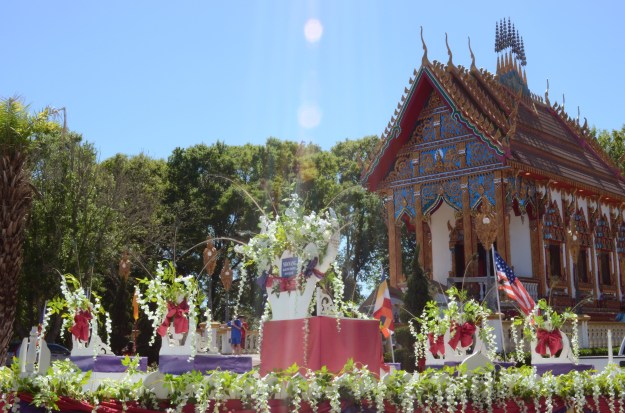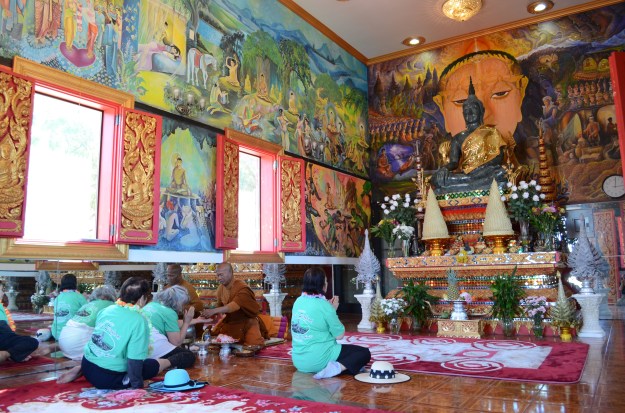In early April, deep in southern Louisiana, there’s a road where dozens of residential garages have been transformed into temporary karaoke bars. Folding chairs and tables covered with liquor bottles sit in the driveways. Speakers blast electronic dance tracks and soulful ballads as revelers line the sidewalks leading to a nearby temple known as Wat Thammarattanaram.
It’s Songkran, the Lao New Year, in Lanexang Village, a neighborhood near the town of Coteau. Loosely translated, lanexang means “million elephants,” and the village is home to hundreds of Laotians and their families, many of them refugees who arrived in the 1980s following the country’s civil war.
The holiday revelry goes late into the night. “Everybody’s welcome,” says Lady Khambounleuang, a local resident. “It’s like a whole Mardi Gras out in the streets.”
Like thousands of other Laotians, Khambounleuang, 35, was born in a refugee camp in Thailand. Her family came to the United States in 1985 and settled in coastal south Louisiana, where there was work in the region’s oil, food-processing, and garment industries. More than 192,000 Laotians migrated to the United States between 1975 and 1988, according to the U.S. Census Bureau; and, though Khambounleuang and others claim it’s a low estimate, about 700 had settled in the Acadiana region by the 1990 census—almost 600 of them in Iberia Parish.

In 1986, several dozen families pooled their savings and purchased the land that would become Lanexang Village. Residents say over the next decade more than 400 Laotians made the village their home.
Phanat Xanamane, 37, arrived in south Louisiana with his family in 1981 and settled in nearby New Iberia.
He volunteers at Wat Thammarattanaram, which was built in 1987, working to raise its profile as a tourist destination and emceeing some of the year’s new year festivities.
The temple, he says, allows Buddhist families like his to continue the rituals of their homeland: The devout leave offerings of food each morning and return in the evening to chant a nightly prayer.
“They had to adapt by constructing this whole village based on this life but make it fit in with the American workweek and the suburban landscape,” says Xanamane, an urban designer.
The temple—a monastery, a sermon hall, a statue pavilion, and a drum pavilion that’s under construction—has become a local tourist attraction. Visitors can find classical Buddhist architecture hidden among the cane fields of semirural Iberia Parish.
A brick wall separates the temple grounds from the rest of the neighborhood. A makeshift mausoleum, it holds the cremated remains of dozens of community members, per Lao tradition. Xanamane says there are plans to build a crematorium at the temple. It will allow mourners to follow the tradition of praying over the bodies of the dead as they are cremated.
But the centerpiece of the temple grounds is the sim, a building used exclusively for the ordination of monks. The sim opens to the public during the new year festival, when worshippers can enter for blessings. Colorful glass and intricate clay carvings adorn the exterior; inside, hand-painted murals surround a large marble statue of Buddha from Thailand.
Completed in 2012, the sim took three years to build—not counting, Xanamane says, the decades it took for the community to build enough wealth to fund an elaborate structure that recalls its homeland.


Much like south Louisiana’s actual Mardi Gras celebrations, the three-day Songkran festival draws people from outside the community and pairs its spiritual traditions with a raucous party. Xanamane and Khambounleuang say a few thousand people attend each year, including from other states.
On Saturday afternoon a parade rolls through the temple grounds. Miss Songkran is selected the night before from among a handful of teenage pageant contestants, all of whom sit atop a flower-laden float at the head of the procession. More floats trail behind. These truck-hauled trailers—which are often adorned with flowers or signs commemorating the event—are typically loaded with speakers, and carry riders who drink, dance, and sing karaoke as the parade crawls through the crowds.
The celebration continues at night with a dance; then on Sunday, at the close of the festival, people spray one another with water hoses to signify cleansing for the new year (this year is 2561, the year of the dog).
Xanamane says his generation feels a responsibility to preserve Laotian traditions. He leads temple tours and has begun putting aside collections from admission fees. He says the money will fund a scholarship to send college students to Laos.
Khambounleuang and her husband established a local youth group that organizes athletic programs and community events at the temple. She says it’s an effort to channel connections between the village’s young people and their Laotian forebears. Although Khambounleuang’s generation grew up speaking Lao at home and learning about the homeland, many in her children’s generation don’t speak the language and feel distant from the culture, she says.
“I don’t want to see this just disappear,” says Khambounleuang, gesturing toward Lanexang Village and the temple. “Because our parents, our grandparents, worked so hard to build this.”